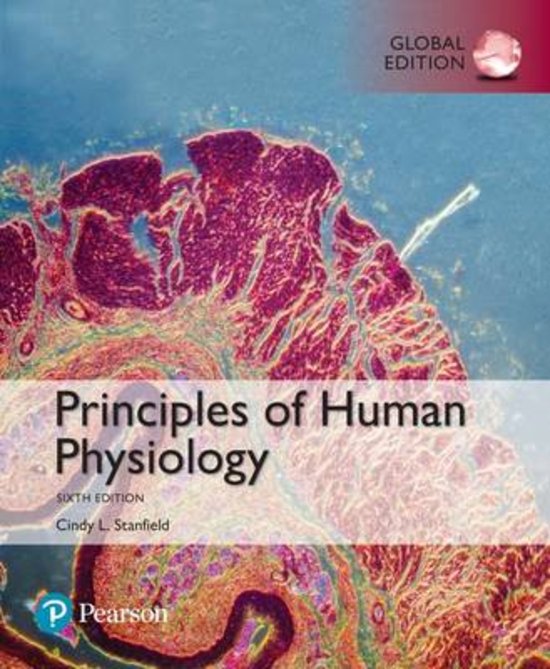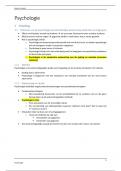Module B – Human and Animal Biology 2
(HAP-20306)
,Inhoud
Principles of Human Physiology ............................................................................................................. 4
Chapter 16 ........................................................................................................................................... 4
Overview of Respiratory Function ................................................................................................... 4
Anatomy of the Respiratory System................................................................................................ 4
Forces for Pulmonary Ventilation.................................................................................................... 5
Factors Affecting Pulmonary Ventilation ........................................................................................ 6
Clinical Significance of Respiratory Volumes and Air Flow.............................................................. 7
Chapter 17 ........................................................................................................................................... 8
Overview of the Pulmonary Circulation .......................................................................................... 8
Diffusion of Gases ............................................................................................................................ 8
Exchange of Oxygen and Carbon Dioxide ........................................................................................ 8
Transport of Gases in the Blood ...................................................................................................... 9
Central Regulation of Ventilation .................................................................................................. 10
Control of Ventilation by Chemoreceptors ................................................................................... 11
Local Regulation of Ventilation and Perfusion .............................................................................. 11
The Respiratory System in Acid-Base Homeostasis....................................................................... 11
Chapter 18 ......................................................................................................................................... 12
Functions of the Urinary System ................................................................................................... 12
Anatomy of the Urinary System .................................................................................................... 12
Basic Renal Exchange Processes .................................................................................................... 14
Regional Specialization of the Renal Tubules ................................................................................ 17
Excretion ........................................................................................................................................ 17
Chapter 19 ......................................................................................................................................... 18
The Concept of Balance ................................................................................................................. 18
Water Balance ............................................................................................................................... 18
Sodium Balance ............................................................................................................................. 18
Acid-Base Balance.......................................................................................................................... 19
Integrated Principles of Zoology .......................................................................................................... 21
Chapter 1 ........................................................................................................................................... 21
Fundamental Properties of Life ..................................................................................................... 21
Chapter 2 ........................................................................................................................................... 21
Origin of Living Systems................................................................................................................. 21
Precambrian Life............................................................................................................................ 22
Chapter 6 ........................................................................................................................................... 22
Darwinian Evolutionary Theory: the Evidence .............................................................................. 22
2
, Revisions of Darwin’s Theory ........................................................................................................ 24
Chapter 9 ........................................................................................................................................... 24
Animal Body Plans ......................................................................................................................... 24
Chapter 10 ......................................................................................................................................... 25
Linnaeus and Taxonomy ................................................................................................................ 25
Taxonomic Characters and Phylogenetic Reconstruction (tot Sources of Phylogenetic
information) .................................................................................................................................. 25
Taxonomic Characters and Phylogenetic Reconstruction ............................................................. 26
Theories of Taxonomy ................................................................................................................... 26
Chapter 23 ......................................................................................................................................... 27
The Chordates ............................................................................................................................... 27
Five Chordate Hallmarks ............................................................................................................... 27
Ancestry and Evolution.................................................................................................................. 28
Subphylum Cephalochordata ........................................................................................................ 28
Subphylum Vertebrata .................................................................................................................. 28
Chapter 24 ......................................................................................................................................... 30
Ancestry and Relationships of Major Groups of Fishes................................................................. 30
Respiration .................................................................................................................................... 31
Chapter 25 ......................................................................................................................................... 31
Chapter 26 ......................................................................................................................................... 32
Origin and Early Evolution of Amniotes (Adaptations of Amniotes) ............................................. 32
Chapter 27 ......................................................................................................................................... 33
Respiratory System of Birds .......................................................................................................... 33
Chapter 28 ......................................................................................................................................... 34
Chapter 30 ......................................................................................................................................... 34
Water and Osmotic Regulation ..................................................................................................... 34
Chapter 31 ......................................................................................................................................... 36
Respiration .................................................................................................................................... 36
3
,Principles of Human Physiology
Chapter 16
Overview of Respiratory Function
Respiration is the process of gas exchange at two levels: the internal respiration (oxygen use within
mitochondria to generate ATP) and the external respiration (exchange of oxygen and carbon dioxide
between the atmosphere and body tissues). The external respiration encompasses four processes:
1. Pulmonary ventilation, movement of air in and out of the lungs by bulk flow.
2. Exchange of oxygen and carbon dioxide between lung air and blood by diffusion.
3. Transportation of oxygen and carbon dioxide between lungs and body tissues by blood.
4. Exchange of oxygen and carbon dioxide between blood and tissues by diffusion.
Anatomy of the Respiratory System
The major organs of this system are the lungs, where the right lung has three lobes and the left lung
two. Air can get to the lungs via the upper airways and then the respiratory tract. The upper airways
are the passages in head and neck, so both nasal and oral cavities, which lead to the pharynx which
then ends into the larynx (part of the respiratory tract). The respiratory tract are all the passages from
the pharynx to the lungs. This tract can be divided into two components, the conducting zone
(functions to conduct air from larynx to lungs, and to humidify, warm and purify the air) and the
respiratory zone (sites where gas exchange occurs). The biggest difference between these two are the
thickness of the walls and if gas exchange is possible.
The conducting zone starts with the larynx,
which is held open by cartilage rings. The
opening to the larynx is called the glottis and is
covered by a flap called the epiglottis, to
prevent food from entering the respiratory
tract. After the larynx, the trachea follows. This
also contains cartilage rings. When the trachea
enters the thoracic cavity, it splits into two
bronchi, one for each lung. Even the bronchi
contain cartilage. The bronchi divide into
smaller secondary bronchi (cartilage is
present, but less). These divide into even
smaller tertiary bronchi. Once the diameters of
the tubes have reached only 1 mm, they are
called bronchioles. These don’t have cartilage,
but contain elastic fibres. The bronchioles end
into the terminal bronchioles. As mentioned
before, the conducting zone’s only function is
to provide a passageway for air to the
respiratory zone. Therefore, air that stays in
this part does not participate in exchange with
blood and thus this zone is called the dead
space.
4
,The composition of the epithelium of the conducting zone changes
as the tubes become smaller. In the larynx and trachea, you find lots
of Goblet cells, which secrete mucus to trap foreign particles. They
also contain lots of cilia to swipe the trapped particles up into the
pharynx where they can be swallowed. As said before, the amount
of cartilage changes too and the amount of smooth muscle changes
in the opposite direction (the smaller the tubes, the more smooth
muscle and the less cartilage). With cystic fibrosis, there is less fluid
under the mucus, which can cause growth delay and airway
infections by defective working of lungs, pancreas, liver and
intestine.
The respiratory zone begins with the respiratory bronchioles which terminate in the alveolar ducts
and these lead into the alveoli. These are mostly arranged in alveolar sacs. There are pores in these
sacs to allow air flow between alveoli. The wall on an alveolus consists primarily of a single layer of
epithelial cells called type I alveolar cells. These epithelial cells have an underlying basement
membrane, which is often fused with the basement membrane of the capillaries. The capillary and
alveolar walls form the respiratory membrane that separates air and blood. There are also type II cells
and alveolar macrophages.
The lungs are located in the thoracic cavity. The chest wall contains structures to
protect the lungs, like the rib cage, the sternum, the thoracic vertebrae, and muscles
and connective tissues. The muscles in the ribs, the internal intercostals and external
intercostals are responsible for breathing, as is the diaphragm. The interior surface of
the chest wall is lined by a pleura (parietal pleura), composed of epithelial cells and
connective tissue. Each lung is surrounded by a pleural sac (visceral pleura). Between
these two pleura, there is the intrapleural space, which is filled with a small amount of
fluid.
Forces for Pulmonary Ventilation
Both air flow and blood flow are examples of bulk flow driven by pressure gradients. A
pressure gradient between the atmospheric air and the air in the lungs is made when
a person inhales and the pressure in the lungs falls. Air will then flow down the gradient
into the lungs. There are four main pressures that are associated with ventilation. First, there is an
atmospheric pressure (Patm) which varies at height. All other lung pressures are expressed relative to
the atmospheric pressure. Second, there is an intra-alveolar pressure (Palv). This pressure is equal to
Patm when at rest. The difference between Palv and Patm during ventilation is the actual gradient. The
5
,intra-alveolar pressure is determined by the quantity of air molecules
and the volume of the alveoli. Third, there is an intrapleural pressure
(Pip). This is the pressure in the intrapleural space. At rest, this pressure
has a negative value in comparison with the atmospheric pressure. This
pressure remains negative during ventilation. Fourth, the
transpulmonary pressure is the difference between the Pip and Palv
(Palv – Pip). It is a transmural pressure, which represents the distending
force across a wall. An increase in transpulmonary pressure creates a
larger distending pressure across the lungs, which is accompanied by the
expansion of the lungs.
Lungs and chest wall are both elastic. Because of this, they both can stretch and then recoil into the
original form. While doing that, they don’t separate because of the surface tension of the intrapleural
fluid that keeps the parietal pleura and visceral pleura from pulling apart. This creates the negative
intrapleural pressure. To maintain this pressure, the pleural sac must be airtight. If air can go into the
intrapleural space, the negative pressure is gone and the lungs collapse. This is called pneumothorax.
The relationship between pressure and volume in the lungs follows Boyle’s law. For a given quantity
of any gas in an airtight container, the pressure is inversely related to the volume of the container.
Thus, if the volume increases, the pressure falls. The lungs are not really airtight containers, so the law
is not strictly followed, but the pressure changes as response to changes in lung volume. The lung
volume in between breaths, at rest, is the functional residual capacity (FRC).
The flow is then described by the following rule, just like blood flow: Flow = (Patm – Palv) / R (resistance).
Factors Affecting Pulmonary Ventilation
Lungs have a relatively high compliance. Lung compliance is defined as the change in lung volume (ΔV)
that results from a given change in transpulmonary pressure: Lung compliance = (ΔV) / Δ(Palv – Pip).
A larger compliance is advantageous, because a smaller change in transpulmonary pressure is then
needed to provide a given volume. That also means that less muscular contraction is needed. The
compliance depends on the elasticity of the lungs and the surface tension of the fluid lining the alveoli.
A high surface tension can be created by strong adhesive forces between molecules in the liquid. A
higher surface tension will lead to more work to spread the liquid, so work is not only needed to expand
the elastic fibres in the connective tissues, but also to increase the surface area of the fluid. Thus,
surface tension decreases compliance.
Pulmonary surfactant is a substance that decreases the surface tension. This is secreted by type II
alveolar cells and it reduces tension because it interferes with hydrogen bonding between water
molecules. Thus the surfactant increases compliance.
Airway resistance refers to the resistance of the entire respiratory system and is analogous to the total
peripheral resistance in the cardiovascular system. It is primarily determined by resistance of individual
airways and affected most by the radius. As radius increases, resistance decreases. When the tubes
branch into smaller tubes, the radii of these tubes decrease. However, the total radius increases, thus
the overall resistance of the conducting zone stays low. Some other things that affect the resistance
are passive forces, contraction of smooth muscles and secretion of mucus.
Passive forces include changes in transpulmonary pressure during ventilation, as well as tractive forces
exerted on airways by the pulling action of tissues surrounding them. They both decrease resistance
during inspiration and increase resistance during expiration. When a person inhales, the airway tubes
6
,may be distended outward, increasing radius and decreasing resistance. However, during expiration,
the tubes recoil inward, decrease the radius and increase the resistance.
Furthermore, when the smooth muscles in the bronchioles contract, they decrease the radii, thus
increase resistance (bronchoconstriction). The opposite is called bronchodilation. The contraction is
controlled by both extrinsic and intrinsic factors. They are influenced by the autonomic nervous
system: sympathetic nerves cause relaxation of the muscles, whereas parasympathetic nerves cause
contraction. Also the release of epinephrine causes relaxation. Histamine causes contraction of the
muscles, which happens during some allergic reactions. It also induces secretion of mucus, increasing
resistance. Moreover, the local carbon dioxide concentration can cause relaxation or contraction.
When the levels are high, relaxation occurs; when levels are low, contraction occurs.
Clinical Significance of Respiratory Volumes and Air Flow
You can measure the volumes of inspired and expired air using a spirometer. With this, you can
measure three of the four lung volumes, which together make up the total lung capacity. The volume
of air that moves in an out of the lungs during a single breath is called the tidal volume (Vt). The
maximum air that can be inspired from the end of a normal inspiration is called the inspiratory reserve
volume (IRV). The maximum volume that can be expired from the end of a normal expiration is called
the expiratory reserve volume (ERV). The volume that remains in the lungs after maximal expiration
is called residual volume (RV). This last one cannot be measured by a spirometer, but with the helium
dilution method for example, it can. The
inspiratory capacity (IC) is the sum of inspiratory
reserve volume and tidal volume (Vt + IRV). The
vital capacity (VC) is the sum of the tidal volume,
the inspiratory reserve volume and the
expiratory reserve volume (Vt + IRV + ERV). The
functional residual capacity is the air remaining in
the lungs at the end of a resting tidal expiration,
which is the sum: ERV + RV. The total lung
capacity (TLC) is the sum of practically all
volumes: TLC = Vt + IRV + ERV + RV.
These and other information can be used to diagnose pulmonary diseases. There are obstructive
diseases, when resistance is increased, and there are restrictive diseases, when lung compliance is
decreased. Other ways to test this are, for example, measuring the forced vital capacity (FVC) and
forced expiratory volume (FEV). To test this, the person has to take a maximum inspiration and then
forcefully exhale as much and as rapidly as possible. Low FVC indicates restrictive diseases and low FEV
indicates obstructive diseases. The maximum rate a person can exhale is the peak expiratory flow rate
(PEFR). Both restrictive and obstructive diseases lead to a decrease of the PEFR.
Minute ventilation (Ve) is the total amount of air that flows in or out of the respiratory system in a
minute. This can be calculated as the tidal volume times the number of breaths per minute, the
respiration rate (RR). But not all air that is inhaled actually participates in gas exchange. The volume
that fills the trachea, bronchi and bronchioles is referred to as the anatomical dead space.
Alveolar ventilation (Va) is a measure of the volume of fresh air reaching the alveoli each minute. It is
similar to the minute ventilation, except that the tidal volume has been corrected for the dead space
volume (DSV): Va = (Vt x RR) – (DSV x RR).
7
, Chapter 17
Overview of the Pulmonary Circulation
Under most conditions, the concentrations of oxygen and carbon dioxide in the systemic arterial blood
vessel are relatively constant because oxygen moves from alveoli to blood at the same rate as it does
from blood to tissue, and this is the same with carbon dioxide. The ratio of the amount of carbon
dioxide produced and the amount oxygen consumed is the respiratory quotient. This varies dependent
on the metabolism.
Diffusion of Gases
The partial pressure of an individual gas is the proportion of the pressure of the entire gas (air) that is
due to the presence of the individual gas. This is determined by two factors, the fractional
concentration of that gas (molarity) and the total pressure exerted by the gas mixture. When, for
example, the pressure of 79% N2 under a total pressure of 760 mm Hg is 0,79 x 760 = 600 mm Hg.
Another factor that influences the diffusion of gases is the solubility of a gas in liquids. Gases in liquids
dissolve until an equilibrium, after that, they turn into gaseous state again. Carbon dioxide is, for
example, 20 times more soluble in water than oxygen. Henry’s law says: c = k x P. C is the molar
concentration, P the partial pressure and k a constant that varies based on gas and temperature. When
a gas is in equilibrium with a liquid, the partial pressure
of the gas in liquid equals the partial pressure of the
gas in air. This does not mean that the concentrations
are the same in liquid and air: the solubility in the
liquid is much lower so the concentration is also lower.
In comparison with carbon dioxide, the concentration
at the same partial pressure would be much higher in
the liquid.
Exchange of Oxygen and Carbon Dioxide
A gas diffuses down its partial pressure gradient. The partial pressure of oxygen and carbon dioxide in
the systemic capillaries is the same as when the blood left the lungs. The actual partial pressure in the
veins leaving the systemic capillaries depends on the metabolic activity and blood flow of that tissue.
So the pressures in different veins can be different depending on activity. When venous blood returns
to the atrium, it mixes together. Therefore, blood in the pulmonary artery is called mixed venous
blood.
The PO2 and PCO2 in alveoli are normally determined by three
factors: the PO2 and PCO2 of the inspired air, the minute
alveolar ventilation, and the rates at which respiring tissues
consume oxygen and produce carbon dioxide. The first one
changes only in different altitudes. The crucial factor is then,
in general, the alveolar ventilation relative to the rate of
oxygen consumption and carbon dioxide production.
Normally, when consumption and production increase,
alveolar ventilation increases as well: hyperpnea. In
hypoventilation, however, alveolar ventilation is
insufficient to the demands. In hyperventilation, alveolar
ventilation exceeds demands.
8








